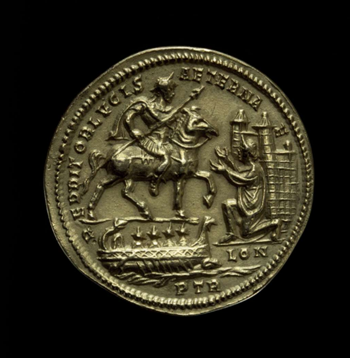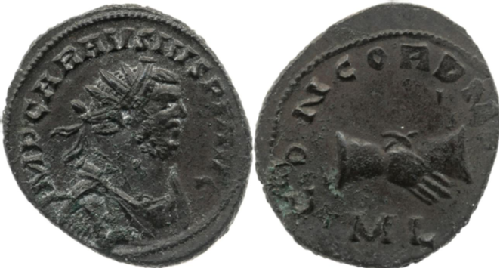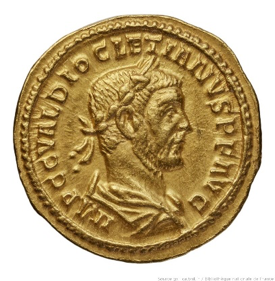All entries for Wednesday 21 September 2022
September 21, 2022
The Arras Medallion: material evidence for reuniting a divided Roman Empire by Giles Penman
After being a province of the Roman Empire for hundreds of years since the emperor Claudius’ invasion in AD 43, a naval commander Marcus Aurelius Mausaeus Carausius led a rebellion in AD 286. Britain and northern Gaul became a separate state for a decade under his rule and that of his finance minister Allectus. The Arras Medallion (Fig. 1), dating from AD 297 is a rare visual depiction of the Roman successful counteroffensive by the emperor Constantius in AD 296. Together with the Panegyric of Constantius it is a key source for this successful military action.
  |
|
Fig. 1: Constantius I, Trier, Arras Medallion, AD 297-305; RIC VI, p. 167, no. 34; BM. 11477.
Obv.: FL VAL CONSTANTIVS NOBIL CAES: legend surrounds bearded bust of Constantius I, r., laureate and draped, wearing a cuirass.
Rev.: REDDITOR LVCIS AETERNA /LON/PTR: legend surrounds scene of Constantius I on horseback riding r. beseeched by Londinium kneeling l. before fortified London; beneath personified Londinium ‘LON’; Beneath Constantius, sailors in ship on sea sailing l.; beneath sailors, ‘PTR’. AU 42mm 36g.
After distinguishing himself in Caesar Maximian’s campaign against the Bagaudae tribe in Gaul in early AD 286, Maximian appointed Carausius, a river pilot from the Menapii tribe in Belgae, north-eastern Gaul, as a military prefect in charge of the Roman naval fleet, the classis Britannica, based in Roman Boulogne, north-western Gaul. Maximian tasked Carausius with patrolling the Oceanus Britannicus or English Channel to suppress Frankish piracy. However, Carausius was accused of allowing the pirates to raid ships and then taking their spoils to enrich himself. Once he learnt that Maximian had ordered his execution, Carausius fled to Britain, revolted and occupied the province later that year. Britannia and Northern Gaul where Carausius soldiers were mainly based seceded from the Roman Empire for the next ten years.
Although historians know little about Carausius’ reign, Carausius minted coins in Londinium with legends and imagery suggesting that he was a legitimate emperor in Britain. For example, an Antoninianus coin (Fig. 2) depicts a bust of Carausius wearing a radiate crown and cuirass with a cloak. This depiction is strikingly similar to the coin depictions of the legitimate Roman emperor Diocletian who is frequently radiate, cuirassed and draped, see for example the aureus in Fig. 3. This presents Carausius as a militarily powerful imperial ruler who is the equal of Diocletian. Similarly, Carausius received and adapted the Diocletian legend ‘IMP C C VAL DIOCLETIANVS P F AVG’ to ‘IMP CARAUSIUS P F AVG’. Carausius appears as the rightful emperor of Britain who claimed the same imperial virtues of loyalty to the Roman state and piety as Diocletian, even though he was an illegitimate usurper of imperial authority. Carausius reigned until he was assassinated by Allectus, his finance minister, in AD 293. Around this time, Constantius, Maximian’s son and successor as Caesar, besieged Boulogne and began rebuilding the Roman fleet.
 |
Fig. 2: Carausius, Londinium, Antoninianus, AD 286 – 293; RIC V, p. , no. 25; BM 1925,0316.157. Obv.: IMP CARAVSIVS P F AVG: legend surrounds bust of Carausius, radiate, draped, cuirassed, r. Rev.: CONCORD MILIT / ML: legend surrounds clasped hands; beneath hands, mint mark ML. AR 4.18g |
  |
Fig. 3: Maximian, Lugdunum, aureus, AD 284-294; RIC V, p. , no. 3; BNF AF.1582 / IMP-10520. Obv.: IMP C C VAL DIOCLETIANVS P F AVG: legend surrounds bust of Diocletian, laureate, draped, r. Rev.: VICTORIA AVG: Victory, winged, draped, standing l., holding wreath in r. hand and palm in l. AU 4.99g |
Constantius’ invasion of Britain, depicted in brief on the medallion, took place in AD 296, for which the Panegyric of Constantius is the only historical literary source. The armies of Constantius under his praetorian prefect Asclepiodotus and other military leaders defeated Allectus and his army of mercenaries in bloody combat (Panegyric 8.16.3). After Allectus’ death in battle, his mercenaries knew they were no longer going to be paid. They began to loot London to make good their losses. Although lost in fog, Constantius’ men slaughtered the looters, saving the provincials. The massacre of the mercenaries, the Panegyric reports, gave the provincials a ‘pleasure of the spectacle’ (Panegyric 8.17). This suggests that the massacre itself was a pleasure for them to behold and that the mercenaries were taken prisoner and used as part of spectacles in the arena. Whatever their exact fate, Constantius’ armies defeated Allectus and brought the province of Britain back under legitimate Roman control.
The medallion’s imagery and legends emphasize the military power and achievements of Constantius. The reverse depicts Constantius on horseback riding to the defence of the personified Londinium. Dressed in a tunic and cuirass and holding a spear, Constantius appears heroic and gallant in his reclamation of Britain and defence of Londinium. The personified city kneels with arms aloft, begging Constantius for assistance lest she be destroyed by the looters. This underscores the desperation of Londinium and Britain in its time of need, and Constantius’ heroism for coming to her rescue. Although he almost certainly was not present in Britain for the invasion and main attack, entrusting leadership instead to his generals including Asclepiodotus, this image creates the impression that Constantius was present, personally led his armies and heroically defeated Allectus’ mercenaries. The reverse legend ‘REDDITOR LVCIS AETERNA’ or ‘the restorer of eternal light’ of Roman civilization to Britain verbalizes Constantius’ great achievement. Even though his soldiers and generals defeated Allectus and his mercenaries, this suggests that Constantius personally has restored Britain from the darkness of separatism to the light of Roman laws, religion and customs. As a restorer of a province, this places Constantius in an imperial tradition of provincial restoration which stretches back to the emperor Hadrian. Constantius appears as a virtuous emperor who has similar qualities to his great deceased predecessors. Indeed, the obverse legend ‘Nobilis Caes’ or ‘Noble Caesar’ reflects Constantius’ exemplary qualities. The obverse image further highlights Constantius’ accomplishment. He wears a laurel wreath, worn by triumphing Roman generals, emperors and their soldiers during a triumphal procession, awarded after a victorious military campaign. Together with a cuirass and cloak, this presents Constantius as a great military leader who achieved a substantial feat by reuniting Britain and northern Gallia with the Roman World and deserves victory spoils. Therefore, even though Constantius was not present at the invasion of Britain, the medallion suggests that he led his army heroically to re-unify Britain with the rest of the Roman Empire.
The deposition site and material of the medallion suggest that it formed part of imperial image creation for the Caesar and later emperor Constantius. The medallion was minted in Trier, northern Germany, but excavated in a coin horde in Beaurains, north-eastern France. Its presence in a horde hundreds of miles from its mint and its substantial weight suggest that medallion had a significant role in transmitting the message of Constantius’ victory in Britain across the Roman World. This emphasizes that the emperor Maximian wished the Roman people to consider Constantius to be a great Roman hero and conqueror who had unified the Roman world. Indeed, the medallion is made from gold, the equivalent in weight of 10 aurei. That the campaign warranted commemoration with a heavy gold medallion, requiring much expensive gold to mint and skill to create, portrays Constantius’ victory as a brilliant feat of arms. Therefore, the gold medallion deposited far from its place of striking shows that it was designed to transmit a significant message about imperial power to Roman citizens.
In conclusion, the naval commander Carausius revolted and occupied Britannia and northern Gaul. Despite being a usurper, he presented himself on locally produced coin legends and imagery as a legitimate imperial ruler, rivalling the emperor Diocletian and his subordinate Caesar Maximian. Allectus, Carausius’ finance minister assassinated him in AD 293. The Panegyric of Constantius is a key source along with the Arras Medallion for Constantius’ invasion. Constantius rebuilt the Roman fleet and invaded Britain in AD 297. The Arras Medallion’s imagery and legend emphasize Constantius’ heroism and gallant actions as the re-unifier of the Roman World and a principled ruler.
Abbreviations and Bibliography
Abbreviations
BM = British Museum.
BNF = Bibliothèque nationale de France, département Monnaies, médailles et antiques.
l. = left.
r. = right.
RIC V = Webb, P. H. (1933). The Roman Imperial Coinage Vol. V Part II (Vol. V ). (H. Mattingly, & E. Sydenham, Eds.) London: Spink and Son Ltd.
RIC VI = Sutherland, C. H. (1967). The Roman Imperial Coinage Vol. VI: Diocletian to Maximinus. London : Spink & Son.
Bibliography
Primary Sources
Ireland, S. (2008). Roman Britain: A Sourcebook. London: Routledge.
Sutherland, C. H. (1967). The Roman Imperial Coinage Vol. VI: Diocletian to Maximinus. London : Spink & Son.
The Trustees of the British Museum. (2022). 'Arras Medallion'. Retrieved September 16, 2022, from The British Museum: https://www.britishmuseum.org/collection/object/C_B-11477
Secondary Sources
Beard, M. (2007). The Roman Triumph . Cambridge : Cambridge University Press.
Casey, P. J. (1994). Carausius and Allectus: The British Usurpers . London: B. T. Batsford Ltd.
Lyne, M. (2003). Some New Coin Types of Carausius and Allectus and the History of the British Provinces AD 286-296. The Numismatic Chronicle, 163, 147-168.
Nixon, C. E., & Saylor-Rodgers, B. (1994). VIII: Panegyricus of Constantius. In C. E. Nixon, & B. Saylor-Rodgers, In Praise of Later Roman Emperors: The Panegyrici Latini: Introduction, Translation, and Historical Commentary with the Latin Text of R. A. B. Mynors (pp. 104-144). Berkeley: University of California Press.
Southern, P. (2004). The Army in Late Roman Britain. In M. Todd (Ed.), A Companion to Roman Britain (pp. 393-408). Oxford: Blackwell Publishing Ltd.
Williams, H. (2004). Carausius: a consideration of the historical, archaeological and numismatic aspects of his reign (BAR British Series). Oxford: British Archaeological Reports Publishing.
 |
This post was written by Giles Penman, who is a final year MPhil student in the Department of Classics and Ancient History, jointly supervised by the Department of History. His thesis concerns the reception of Greco-Roman imagery on British civic cultural artefacts of the Great War 1914-1918 and the Inter-War Period 1919-1938 to mobilise British people for the war effort and post-war commemoration. |
 Jacqui Butler
Jacqui Butler

 Please wait - comments are loading
Please wait - comments are loading
 Loading…
Loading…